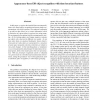Free Online Productivity Tools
i2Speak
i2Symbol
i2OCR
iTex2Img
iWeb2Print
iWeb2Shot
i2Type
iPdf2Split
iPdf2Merge
i2Bopomofo
i2Arabic
i2Style
i2Image
i2PDF
iLatex2Rtf
Sci2ools
ICIAP
2007
ACM
2007
ACM
Appearance-based 3D object recognition with time-invariant features
In this paper we explore the interlink between temporally dense view-based object recognition and sparse image representations with local keypoints. The temporal component is an add on that allows us to extract information which is distinctive of a given object in a given view-point range. We use temporal descriptions both for training and for testing. In the training phase each image sequence contains one object only, observed at different view points. At run time video shots are analyzed looking for known objects. Train and test video shots are represented by a structure of scale-space keypoints selected so that they are robust to view-point changes. In the matching phase we emphasize co-occurring keypoints and attenuate the importance of isolated points, both in the model and in the test representation. With our prototype recognition system we obtained very good results in controlled and unconstrained environments, setting the ground for real world applications such as automatic pl...
Co-occurring Keypoints | ICIAP 2007 | Image Processing | Scale-space Keypoints | View-based Object Recognition |
| Added | 08 Dec 2009 |
| Updated | 08 Dec 2009 |
| Type | Conference |
| Year | 2007 |
| Where | ICIAP |
| Authors | Elisabetta Delponte, Nicoletta Noceti, Francesca Odone, Alessandro Verri |
Comments (0)

